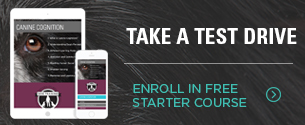 Dog training is a hands-on profession, but not all teaching needs to take place in a class or a home training session. Print materials that clients can take home and social media resources you share online help strengthen your learning connection with your clients between in-person sessions.
Dog training is a hands-on profession, but not all teaching needs to take place in a class or a home training session. Print materials that clients can take home and social media resources you share online help strengthen your learning connection with your clients between in-person sessions.
While printed guides and online infographics won’t replace the value of your expertise in class, written aids help dispel myths, provide interesting factual information, and help guide pet parents when you’re not right at their side. Your most eye-catching and interesting information will be shared by your clients with other pet-parents, boosting your business visibility, too.
4 common template marketing materials
While you may not really want to add another task to your to-do list, the most important thing to remember about today’s marketing and education materials is that, once you’ve created them, template materials are fairly easy to customize and update. They are computer-created graphics and documents that you build using a graphic design program. There are a number of web-based programs that are free or low-cost and easy to use. Once you’ve created a design, you can copy it and use it as a template to add new information whenever you need to. This speeds up your ability to create new, shareable educational materials.
Here are some examples of digital and printable marketing materials:

Source: Working with Dog
Infographics: You’ve seen them all over the internet, or within an emailed newsletter, or as a bright splash of visual info in the middle of an online article. Infographics simplify complex subjects into a short, friendly, colorful format that’s easy for your audience to engage with. You’ve probably seen titles like “10 Tips to Keep Your Dog Safe in the Summer Heat” or “5 Human Foods to Avoid Feeding Your Pet.”
Educational flyers: You’ve certainly noticed these posted in your veterinarian’s office. They are eye-catching, handbill-sized posters on the benefits of microchipping, the dangers of vaccine-related sarcomas, or a colorful body-condition charts for dogs or cats. Not only did they give you something to read as you wait for the veterinary technician to start your visit, you learn something new, too.
Social media graphics: From a social post celebrating Train Your Dog Month to a colorful image announcing your next Loose Leash Walking class, eye-catching social media graphics grab people’s attention and put the brakes on their relentless screen-scrolling. Text alone simply doesn’t have that power.
Professional summaries. You may have been handed one of these after a doctor’s visit, summarizing the reason for your visit, your weight and blood pressure reading, a suggested diagnosis, and any drugs you were prescribed. While there was probably a lot of tiny print (all those drug side effects!) the headings are in a clean, large format so you can scan it quickly. A dog trainer would never need to create such a text-dense document, but you get the idea. When professionals hand their clients a personalized summary or follow-up, the client is far more likely to understand what they were told in their actual session, and can refer to it when they have questions.
How can dog trainers use the materials to create stronger connections?
Just like doctors and veterinarians, dog trainers can also use shareable or print resources to help create a smoother, more comfortable experience for their clients, and to continue to educate outside of the actual dog training session. Here are just a few ideas to get you thinking about how these resources can fit into your own business:
A “How to Prepare for Your First Day of Dog Training” flyer. A colorful, clear, and easy-to-read flyer that you can update as needed will be simple for new clients to review and share with the rest of the family. You can embed it in an email, send it as a downloadable attachment, or include it as an image on your web page. Actual drawings or photos of the type of collar, leash, or harness you expect them to use will help prevent equipment misunderstandings.
A printable training plan or training homework tracker. Some people will always love paper, and the opportunity to track their progress daily can help keep clients on course with their dog training homework, especially if more than one family member will be helping with at-home training. After you create the original training plan on your computer, you can customize each form to match your clients’ unique dog training needs.
Infographics for sharing on social media or to include in your newsletter will help strengthen your reputation as expert in dog training and behavior, even when you aren’t physically with your clients. Topics don’t necessarily have to be specific to dog training, but they should be of interest to dog-loving people, like:
-
- Things to Consider When Thinking About Adopting a Puppy
- 10 Things to Include in a Travel Kit For Your Dog
- How to Make Veterinary Trips Less Stressful
- Five Reasons to Crate-Train Your Puppy
- What is the Difference Between Positive and Negative Reinforcement?
- How Not to Greet a Strange Dog
- Teaching Your Dog to Leave It

Source: Working with Dog
Where can you find ideas?
Looking for inspiration is just a Google or Pinterest search away. Just type in “Dog training graphics” and set an alarm so you don’t fall down a rabbit hole of ideas. Check out these resources:
-
- The National Today Calendar https://nationaltoday.com/animal-holidays/
- The ASPCA social media calendar, updated quarterly
- Join a pet business marketing community like Working with Dog. The visual examples in this article came from their member library of customizable graphics.
- Don’t forget Google! By typing in the beginning of pet-related questions, like “Why does my dog…” or “How do I stop my dog from…” you’ll see that the drop-down search box populates with trending questions that pet-parents are asking. You can create an infographic or flyer that provides the accurate answers people are looking for.
- Pinterest will show you the great ideas others have come up with. However, use these as inspiration — don’t take the designs of others for your own.
As a dog trainer, you probably can accurately answer many dog-related questions without help. However, you may need to research or verify some answers you plan to use in your social media posts, infographics, or tip sheets. Be sure to record the source you used in case you are ever questioned. If you paraphrase or quote another expert, be sure to cite the source of the information right on your graphic or in your document. And when sharing graphics from other organizations on your own social feed, share from the original source whenever you can. After all, when you create original graphics of your own, you’ll want others to share straight from your social feed, too!
Include your logo and a call to action
The primary purpose of a daily training tracker form or your “How to Prepare for Your First Day of Dog Training” flyer is to help set your dog-training clients up for success. Infographics are also powerful educational tools. However, all of these materials are part of your marketing toolkit. They are seen and shared by people, and they may ultimately reach potential new clients.
Always include your logo, website address, and a clear call to action like an invitation to sign up for your email list or follow you on social media. On printed flyers, you could also include a scannable QR code that will take the person right to your website. When your online or print materials reach new people, they’ll be able to find your business easily.
Free tools can help you on your way
At this point, you may be thinking “I can do that!” and you’re off and running to fire up your computer. Or you may be thinking “Don’t you need an expensive computer program to build colorful infographics or fancy flyers?
Canva is an easy-to-use web-based design program with a free and a paid “Pro” version. You can use their own images or upload your own, upload your logo, and quickly build graphics that you can use on social media, your website, email to clients, or print and post. A quick search on YouTube will turn up tutorials for almost any free or paid graphic tool you might encounter.
If you aren’t a photographer and need images, try Pexels and Unsplash for free image libraries full of pet pics that will make your creations stand out.
Expand your dog-training expertise and share it with the world!
By using infographics, flyers, and social media posts, you may inspire someone to think more deeply about their relationship with their dog. By exposing yourself to new ideas, you’ll find yourself growing more excited about your own business plans, too. If you are looking for an opportunity to take your dog training business and behavior expertise to the next level, The Victoria Stilwell Dog Trainer Academy Dog Trainer Course may be just the spark you need to light that creative fire!



